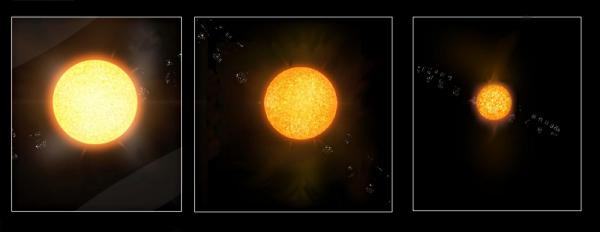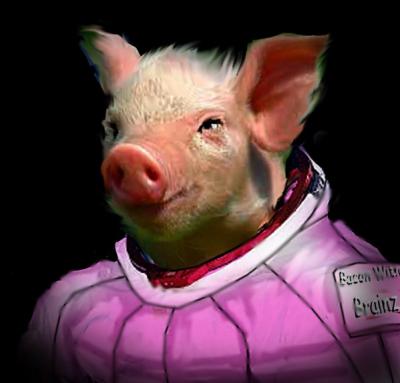BY LETTER
Unon-Duuz
Galactography > Regions of Space > Inner Sphere
Galactography > Systems and Worlds > Systems & Worlds U - V
Galactography > Sephirotic Empires > Terragen Federation
Galactography > Systems and Worlds > Systems & Worlds U - V
Galactography > Sephirotic Empires > Terragen Federation
Terragen Federation trinary system surrounded by multiple orbital bands | |
 Image from Steve Bowers | |
| The three stars of Unon-Duuz, showing the innermost orbital bands around each star and stellar modification technology around GJ1245A | |
Unon-Duuz | |
| System | Unon-Duuz |
|---|---|
| Primary | GJ 1245 A, B, and C Note: GJ1245A and C (Duuz) orbit each other at distance of 8AU, while GJ1245B (Unon) orbits the combined A-C binary at a distance of 33AU |
| Distance from Sol | 15.4ly |
| Stellar Class | GJ1245A - M5.5 Ve, 0.11 Solar masses; GJ1245B - M6V, 0.10 Solar masses; GJ1245C - M V, 0.07 Solar masses |
| Luminosity | GJ1245A - 0.000084x Sol; GJ1245B - 0.000048x Sol; GJ1245C - 0.074x Sol |
| Modified Luminosity | GJ1245A - 0.07x Sol Note: All three stars in the Unon-Duuz system have been subject to modest stellar husbandry intervention, primarily focused on flare management. The A component has been enhanced using starbooster technology, increasing its apparent luminosity. |
| Region | Inner Sphere |
| Planets | None. Several medium size asteroid belts orbit each of the stars, and an extensive Kuiper Belt and Oort Cloud are located in the outermost reaches of the system |
Important Local Artificial Intelligence | |
| AI overseer | The Black Cabinet - Semi-mythical council of Second Singularity minds that is rumored to either advise, control, or manipulate (depending on the source) the official governing apparatus of the system (cyberdemocratic augmentocracy). |
|---|---|
| AI Ethos | Mostly non-interventionist, but periodically issues advisories on a variety of subjects from politics to social interactions, to the economy. Is strongly rumored to occasionally manipulate populations and events in secret to maintain stability or achieve desired outcomes. |
| Allegiance | Terragen Federation |
| Colonized | 1203AT |
Economics and Local Infrastructure | |
| Major Industries | Habitat biome design and templating, custom virch design, dreamweaving, hedonics tourism, transit routing, intercultural mediation and memetics services. Stellar husbandry and materials extraction feeding three Deep Well Industrial Zones provides the majority (68 percent) of local heavy elements, although asteroid and comet mining provides the remainder and virtually all volatiles. |
|---|---|
| Angelnetting | Angelnetting is employed to varying degrees throughout the orbital bands, depending on the desires of the inhabitants. |
| Major Orbitals | 300 million habitats spread across nine major orbital bands (A component - 5 bands, B component - 3 bands, C component - 1 band), twenty-four hotpoint habitat clusters in the local Kuiper Belt, and several million mobile units in transit. Habitat designs vary across a range of styles and types, including cylinders, spheres, torii, freespheres, discworlds, orwoods, various freefall structures, and custom designs incorporating elements of all of the preceding. Many habitats are designed to easily restructure themselves as desired and at any given time some 15 percent of the local habitats may be engaged in such activities. Many habs are either designed for mobility from the start, or will reconfigure themselves for such before relocating to another orbital band, one of the local hotpoints in the outer system, or simply into an extended cometary orbit that takes them some great distance from the majority of the system's population for a period of quiet reflection, comparative cultural isolation, or simply to work on some new product, artwork, or meme in comparative secrecy. While Unon-Duuz habs are rarely more than 100km across in any major dimension, their numbers allow for a wide range of environments and biomes, often operating on asynchronous seasonal cycles. This allows the local inhabitants to readily customize their living conditions to whatever they happen to prefer at the time. Repeated relocation from one hab to another is common and considered a normal part of everyday life. |
| Population | 375 billion Population breakdown: 33 percent cyborg tweak - high radiation, space, and vacuum adapted 22 percent Neo-pig 13 percent Vec - mainly Adumbrans, Environmental Vecs, Shogs, and Starhand 12 percent Raffin 10 percent Infomorph (Upload, AI, and A-life) 5 percent Rainbow Bubbles 5 percent Near-baseline human |
Travel | |
| Spaceports | Not applicable. Virtually all habitats in the system have docking facilities and can accommodate anywhere from one to several hundred spacecraft of various sizes and types. |
|---|---|
| Cycler Routes | 5 beam-lines |
| Hazard Rating | 0.0 to 2, depending on where a visitor is at any given moment. |
| Visa Restrictions | Open Access |
System Overview
One of a number of systems in the Inner Sphere that serve as a major point of contact between the Deeper Covenant and the wider Sephirotic Empires, Unon-Duuz is a study in contrasts. Its position at a junction of five major beamlines in the Beamrider Network as well as connections via commgauge wormhole to the wider galaxy makes it a local hub and a major center of cultural blending. At the same time, its somewhat inward turned culture gives it an air of distance from the bustle of galactic civilization around it. Most Unon-Duuzi are content to travel among the many clusters and archipelagos of habitats scattered among the three suns and numerous hotpoints of their system, rarely concerning themselves with events elsewhere. At the same time, they are well-regarded as suppliers of custom virtualities and dream-constructs in over 300 star systems, while several of their mediation and memetics packages are considered a standard across almost a tenth of a percent of the entire Terragen Federation.Structurally and demographically, the system's orbital bands are divided primarily on the basis of radiation resistance or, in the case of the majority cyborg population, radiation consumption. A combination of gengineered tweaks and cybernetic augmentations means that virtually all of the so-called 'radbot' portion of the population is not only able to survive in the high radiation environment of a major flare event (a common occurrence with M-class stars), but find such to be actively energizing and pleasurable. As a result, the majority of this clade are found occupying the innermost orbital bands as well as specialized close-orbit hedonics habitats designed to work in conjunction with local flare management to channel energized particles into themselves for the benefit of their inhabitants as well as the many visitors (local and interstellar) who come for the bi-annual orgy festivals.
History and Colonization
In the centuries after contact between the First Federation and Deeper Covenant was established, both groups were eager to engage in greater interaction, including mutually agreed upon data and communication protocols, extensive diplomatic and trade missions, and a number of joint projects. The colonization of the GJ 1245 system was one of these.Visited by a Deeper flyby probe over a century before, and telescopically surveyed prior to the mission setting out, the system was determined to contain no significant planets, but was home to several asteroid belts and a respectable Oort cloud. Of particular interest to the Deepers, GJ 1245 was also located equidistantly from no less than three brown dwarves, ranging from 1.5 to 3.3 light-years from the central stars and offering the potential to act as the backbone of a major extension of the Beamrider Network.
Both the Federation and the Covenant were also excited by the potential synergies between their respective areas of expertise. Federation anti-matter drives and near-solar engineering combined with Deeper mass-beam technology and deep-space habitat construction methods held the potential to allow both civilizations to expand more quickly into new areas, and develop them more efficiently. The colony expedition was one of several projects designed to be proofs-of-concept of the advantages and methodologies of cooperation.
Launched from Sol System in 1123AT using temporarily retargeted Deeper boostbeams, the ships of the combined expedition accelerated to a cruising velocity of .2c with virtually no reaction mass loss. After 75 years of interstellar flight, Federation amat drives, augmented by Deeper mag-brakes, decelerated the colony fleet into orbit around the triple suns, now renamed Unon-Duuz by Rainbow Shards of Midnight, the S1 governor of the expedition, apparently as a play on words in Esperanto.
 Image from Steve Bowers | |
| Neopig pioneer, one of the first colonists in this system | |
Even as the ships were shedding the last of their velocity and taking up orbit around the Duuz binary, they released Neumann replicators into the nearby asteroid belts, and development of the system began. Within a century, the original 10,000 sophonts of the expedition had grown to over a million and several small habitat archipelagos had been built around all three stars. In addition, automated construction systems had been launched toward each of the nearby brown dwarfs with the goal of establishing basic cycler routes to all three.
Over the next several thousand years, development of the Unon-Duuz system remained steady, largely pacing itself to the growth of the population. Asteroid and comet mining were eventually augmented and then largely replaced by star mining, which in turn led to the establishment of stellar husbandry systems designed to moderate and channel the frequent flares that M-class stars are often subject to. The installation of a starbooster system in 7822 completed the conversion of what had once been a new frontier into an established Old Core system, filled with history, ancient customs, and many, many ways to have a good time, if one is to believe the tourism notices.
Related Articles
- Beamrider Network
- Jinvanco (Struve 2398)
- Neo-Pigs
- Orbital Band
- Star Lifting
- Starbooster
- Stellar Engineering - Text by M. Alan Kazlev
Modifying or customizing a star in any manner. Could be for the purposes of stellar husbandry, or for more exotic purposes. - Stellar Husbandry
Appears in Topics
Development Notes
Text by Todd Drashner
Initially published on 21 June 2016.
Initially published on 21 June 2016.






